Water Saving and Yield of Potatoes under Partial Root-Zone Drying Drip Irrigation Technique: Field and Modelling Study Using SALTMED Model in Saudi Arabia
Abstract
1. Introduction
1.1. PRD Irrigation Technique
1.2. SALTMED Model
2. Materials and Methods
2.1. Location
2.2. Climate
2.3. Field Experiment
2.4. Fertilization
2.5. Daily Readings of Plant Environment Data
2.6. Crop Water Requirement
2.6.1. Lysimeters
2.6.2. Pan Evaporation
2.6.3. Penman-Monteith
2.7. SALTMED Model
Model Statistical Analyses
3. Results
3.1. Potato Crop Water Requirements
3.2. Potato Yield
3.3. SALTMED Data
3.3.1. Water Applied at 150% of ETc
Soil Moisture Distribution
Soil Salinity Distribution
Soil Nitrogen
3.3.2. Water Applied at 100% of ETc
Soil Moisture Distribution
Soil Salinity Distribution
Soil Nitrogen
3.3.3. Water Applied at 50% of ETc
Soil Moisture Distribution
Soil Salinity Distribution
Soil Nitrogen
The Yield
4. Discussion
4.1. Crop Water Requirements
4.2. The Effect of Water Application on Yield during the Spring Season
4.3. The Effect of Water Application on Yield during the Fall Season
4.4. SALTMED
5. Conclusions
Author Contributions
Funding
Acknowledgments
Conflicts of Interest
References
- Ragab, R.; Malash, N.; Abdel Gawad, G.; Arslan, A.; Ghaibeh, A. A holistic generic integrated approach for irrigation, crop and field management 2. The SALTMED model validation using field data of five growing seasons from Egypt and Syria. Agric. Water Manag. 2005, 78, 89–107. [Google Scholar] [CrossRef]
- Collins, M.J.; Fuentes, S.; Barlow, E.W. Partial rootzone drying and deficit irrigation increase stomatal sensitivity to vapour pressure deficit in anisohydric grapevines. Funct. Plant Biol. 2010, 37, 128–138. [Google Scholar]
- Dodd, I.C.; Theobald, J.C.; Bacon, M.A.; Davies, W.J. Alternation of wet and dry sides during partial rootzone drying irrigation alters root-to-shoot signalling of abscisic acid. Funct. Plant Biol. 2006, 33, 1081–1089. [Google Scholar] [CrossRef] [PubMed]
- Ahmad, S.; Raza, M.A.S.; Saleem, M.F.; Zaheer, M.S.; Iqbal, R.; Haider, I.; Khan, I.H. Significance of partial root zone drying and mulches for water saving and weed suppression in wheat. J. Anim. Plant. Sci. 2020, 30, 154–162. [Google Scholar]
- Mattar, M.A.; El-Abedin, T.K.Z.; Alazba, A.A.; Al-Ghobari, H.M. Soil water status and growth of tomato with partial root-zone drying and deficit drip irrigation techniques. Irrig. Sci. 2018, 38, 163–176. [Google Scholar] [CrossRef]
- Dry, P.R.; Stoll, M.; Mc Carthy, M.G.; Loveys, B.R. Using plant physiology to improve the water use efficiency of horticultural crops. In Proceedings of the III International Symposium on Irrigation of Horticultural Crops 537, Lisbon, Portugal, 28 June 1999; pp. 187–197. [Google Scholar]
- Ragab, R. A holistic generic integrated approach for irrigation, crop and field management: The SALTMED model. Environ. Model. Softw. 2002, 17, 345–361. [Google Scholar] [CrossRef]
- Marwa, M.A.; El-Shafie, A.F.; Dewedar, O.M.; Molina-Martinez, J.M.; Ragab, R. Predicting the water requirement, soil moisture distribution, yield, water yield of peas and impact of climate change using SALTMED model. Plant. Arch. 2020, 20, 3673–3689. [Google Scholar]
- Alkhasha, A.; Al-Omran, A. Simulated tomato yield, soil moisture, and salinity using fresh and saline water: Experimental and modeling study using the SALTMED model. Irrig. Sci. 2019, 37, 637–655. [Google Scholar] [CrossRef]
- Kaya, Ç.I.; Yazar, A. Saltmed Model Performance for Quinoa Irrigated with Fresh and Saline Water in a Mediterranean Environment. Irrig. Drain. 2016, 65, 29–37. [Google Scholar] [CrossRef]
- Kaya, Ç.I.; Yazar, A.; Sezen, S.M. SALTMED Model Performance on Simulation of Soil Moisture and Crop Yield for Quinoa Irrigated Using Different Irrigation Systems, Irrigation Strategies and Water Qualities in Turkey. Agric. Agric. Sci. Procedia 2015, 4, 108–118. [Google Scholar] [CrossRef]
- Pulvento, C.; Riccardi, M.; Lavini, A.; D’andria, R.; Ragab, R. SALTMED model to simulate yield and dry matter for quinoa crop and soil moisture content under different irrigation strategies in south Italy. Irrig. Drain. 2013, 62, 229–238. [Google Scholar] [CrossRef]
- Abdelraouf, R.E.; Ragab, R. The Benefit of Using Drainage Water of Fish Farms for Irrigation: Field and Modelling Study Using the SALTMED Model. Irrig. Drain. 2017, 66, 758–772. [Google Scholar] [CrossRef]
- Abdelraouf, R.E.; Ragab, R. Applying partial root drying drip irrigation in the presence of organic mulching. Is that the best irrigation practice for arid regions? Field and modelling study using the SALT-MED model. Irrig. Drain. 2018, 67, 491–507. [Google Scholar] [CrossRef]
- Gawad, G.A.; Arslan, A.; Gaihbe, A.; Kadouri, F. The effects of saline irrigation water management and salt tolerant tomato varieties on sustainable production of tomato in Syria (1999–2002). Agric. Water Manag. 2005, 78, 39–53. [Google Scholar] [CrossRef]
- Hirich, A.; Choukr-Allah, R.; Ragab, R.; Jacobsen, S.E.; El Youssfi, L.; El Omari, H. The SALTMED model calibration and validation using field data from Morocco. J. Mater. Environ. Sci. 2012, 3, 342–359. [Google Scholar]
- Silva, L.L.; Ragab, R.; Duarte, I.; Lourenço, E.; Simões, N.; Chaves, M.M. Calibration and validation of SALTMED model under dry and wet year conditions using chickpea field data from Southern Portugal. Irrig. Sci. 2013, 31, 651–659. [Google Scholar] [CrossRef]
- Chauhdary, J.N.; Bakhsh, A.; Ragab, R.; Khaliq, A.; Engel, B.A.; Rizwan, M.; Nawaz, Q. Modeling corn growth and root zone salinity dynamics to improve irrigation and fertigation management under semi-arid conditions. Agric. Water Manag. 2020, 230, 105952. [Google Scholar] [CrossRef]
- Noshadi, M.; Fahandej-Saadi, S.; Sepaskhah, A.R. Application of SALTMED and HYDRUS-1D models for simulations of soil water content and soil salinity in controlled groundwater depth. J. Arid. Land 2020, 12, 447–461. [Google Scholar] [CrossRef]
- Duisebek, B.; Shahgedanova, M.; Wade, A.; Ragab, R. Testifying SALTMED model using field data in Almaty region, South-east Kazakhstan. EGU General Assembly Conference Abstracts. 2020. Available online: https://ui.adsabs.harvard.edu/abs/2020EGUGA..22.7705D/abstract (accessed on 25 November 2020).
- Ministry of Water and Electricity. Annual Report; Ministry of Water and Electricity: Riyadh, Saudi Arabia, 2009.
- Al-Omran, A.M.; Mohammad, F.S.; Alghobari, H.M.; Alazba, A.A. Determination of evapotranspiration of tomato and squash using lysimeters in central Saudi Arabia. Int. Agric. Eng. J. 2004, 13, 27–36. [Google Scholar]
- Allen, R.G.; Pereira, L.S.; Raes, D.; Smith, M. Crop Evapotranpiration Guidelines for Computing Crop Water Requirements; FAO Irrigation and Drainage Paper 56; FAO Food and Agriculture Organization of the United Nations: Rome, Italy, 1998. [Google Scholar]
- Loague, K.; Green, R.E. Statistical and graphical methods for evaluating solute transport models: Overview and application. J. Contam. Hydrol. 1991, 7, 51–73. [Google Scholar] [CrossRef]
- Al-Omran, A.; Eid, S.; Alshemmary, F. Crop water requirements of date palm based on actual applied water and Penman–Monteith calculations in Saudi Arabia. Appl. Water Sci. 2019, 9, 69. [Google Scholar] [CrossRef]
- Brouwer, C.; Heibloem, M. Irrigation Water Management: Irrigation Water Needs; Training Manual No. 3; FAO Food and Agriculture Organization of the United Nations: Rome, Italy, 1986. [Google Scholar]
- Zhang, G.; Shen, D.; Ming, B.; Xie, R.; Jin, X.; Liu, C.; Hou, P.; Xue, J.; Chen, J.; Zhang, W.; et al. Using irrigation intervals to optimize water-use efficiency and maize yield in Xinjiang, northwest China. Crop. J. 2019, 7, 322–334. [Google Scholar] [CrossRef]
- El-Shafie, A.F.; Osama, M.A.; Hussein, M.M.; El-Gindy, A.M.; Ragab, R. Predicting soil moisture distribution, dry matter, water yield and potato yield under a modified gated pipe irrigation system: SALTMED model application using field experimental data. Agric. Water Manag. 2017, 184, 221–233. [Google Scholar] [CrossRef]
- Afzal, M.; Battilani, A.; Solimando, D.; Ragab, R. Improving water resources management using different irrigation strategies and water qualities: Field and modelling study. Agric. Water Manag. 2016, 176, 40–54. [Google Scholar] [CrossRef]
- Karandish, F.; Šimůnek, J. A comparison of the HYDRUS (2D/3D) and SALTMED models to investigate the influence of various water-saving irrigation strategies on the maize water footprint. Agric. Water Manag. 2019, 213, 809–820. [Google Scholar] [CrossRef]
- Hassanli, M.; Ebrahimian, H.; Mohammadi, E.; Rahimi, A.; Shokouhi, A. Simulating maize yields when irrigating with saline water, using the AquaCrop, SALTMED, and SWAP models. Agric. Water Manag. 2016, 176, 91–99. [Google Scholar] [CrossRef]
- Razzaghi, F.; Plauborg, F.; Ahmadi, S.H.; Jacobsen, S.E.; Andersen, M.N.; Ragab, R. Simulation of quinoa (Chenopodium quinoa Willd.) response to soil salinity using the SALTMED model. In Proceedings of the IICID 21st International Congress on Irrigation and Drainage, Tehran, Iran, 15–23 October 2011. [Google Scholar]
- Fghire, R.; Wahbi, S.; Anaya, F.; Issa Ali, O.; Benlhabib, O.; Ragab, R. Response of quinoa to different water management strategies: Field experiments and SALTMED model application results. Irrig. Drain. 2015, 64, 29–40. [Google Scholar] [CrossRef]
- Rameshwaran, P.; Tepe, A.; Yazar, A.; Ragab, R. The Effect of Saline Irrigation Water on the Yield of Pepper: Experimental and Modelling Study. Irrig. Drain. 2015, 64, 41–49. [Google Scholar] [CrossRef]
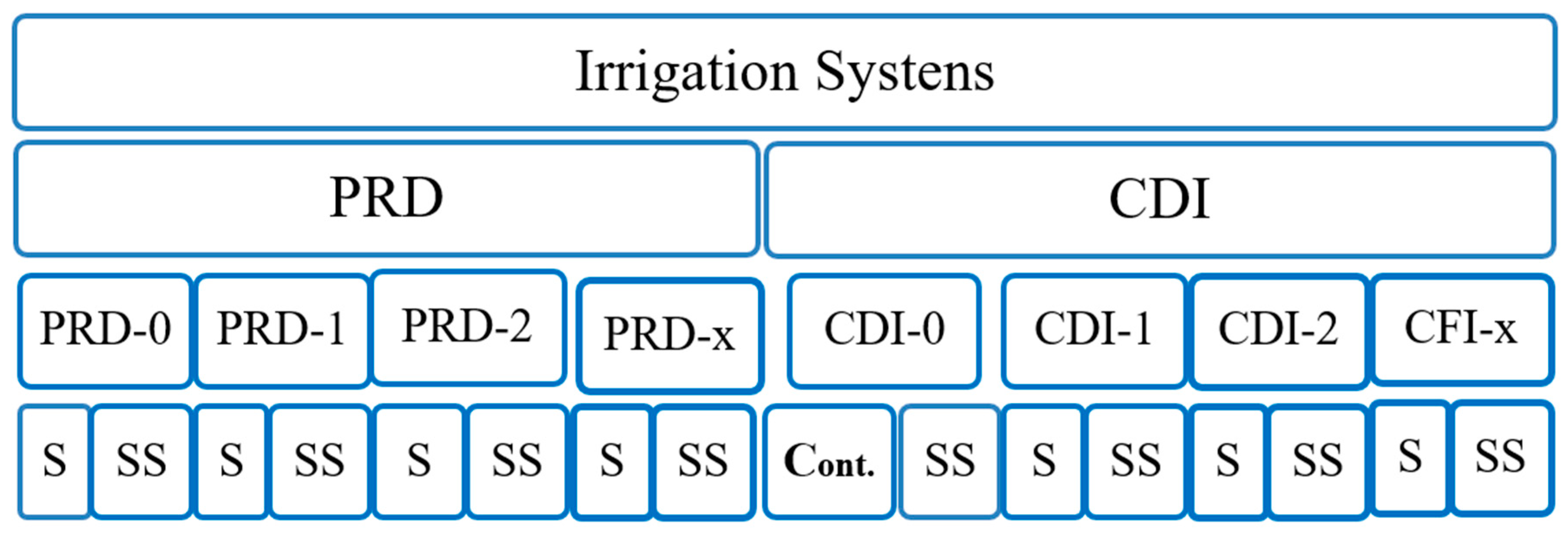

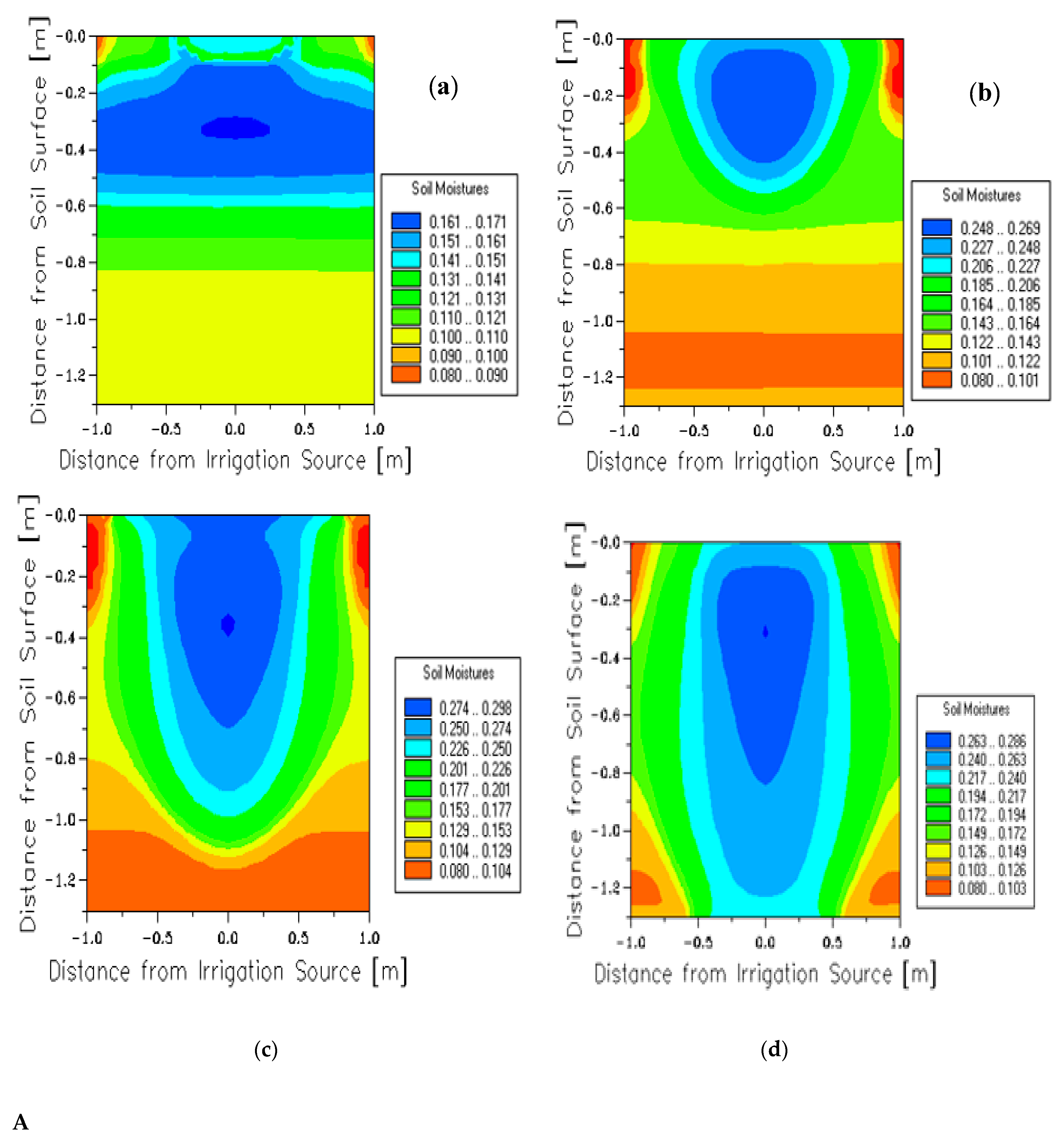

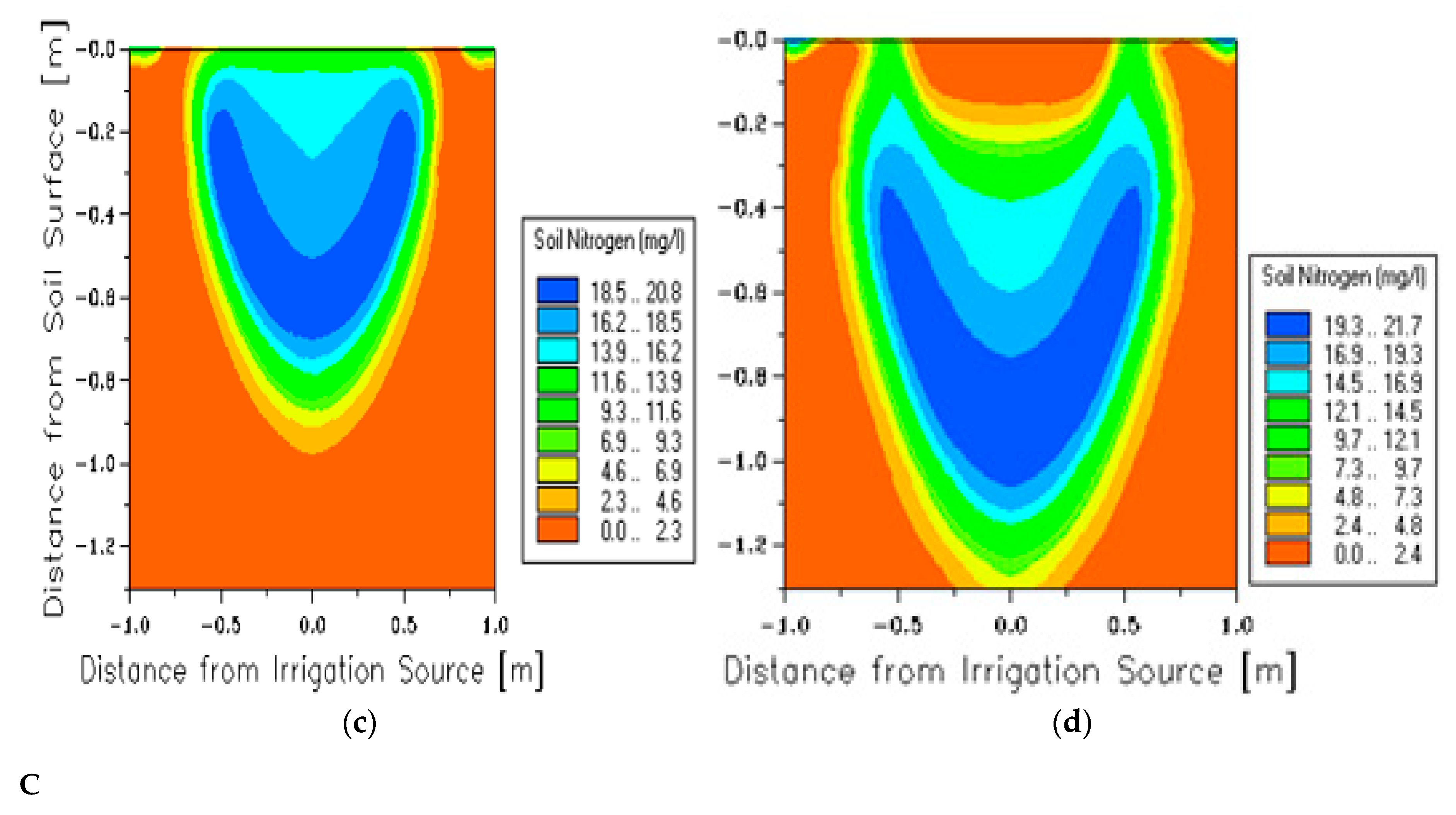
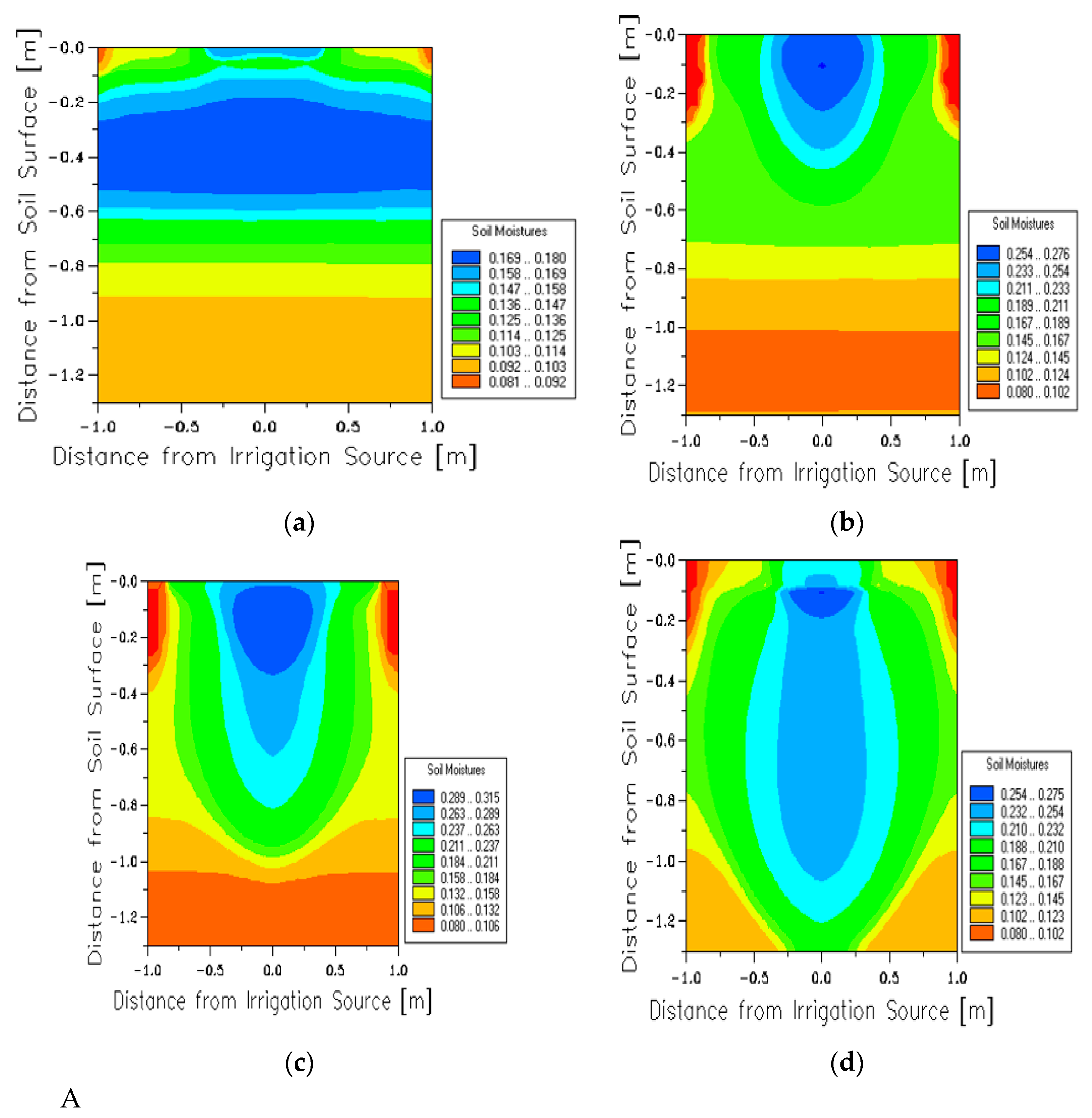
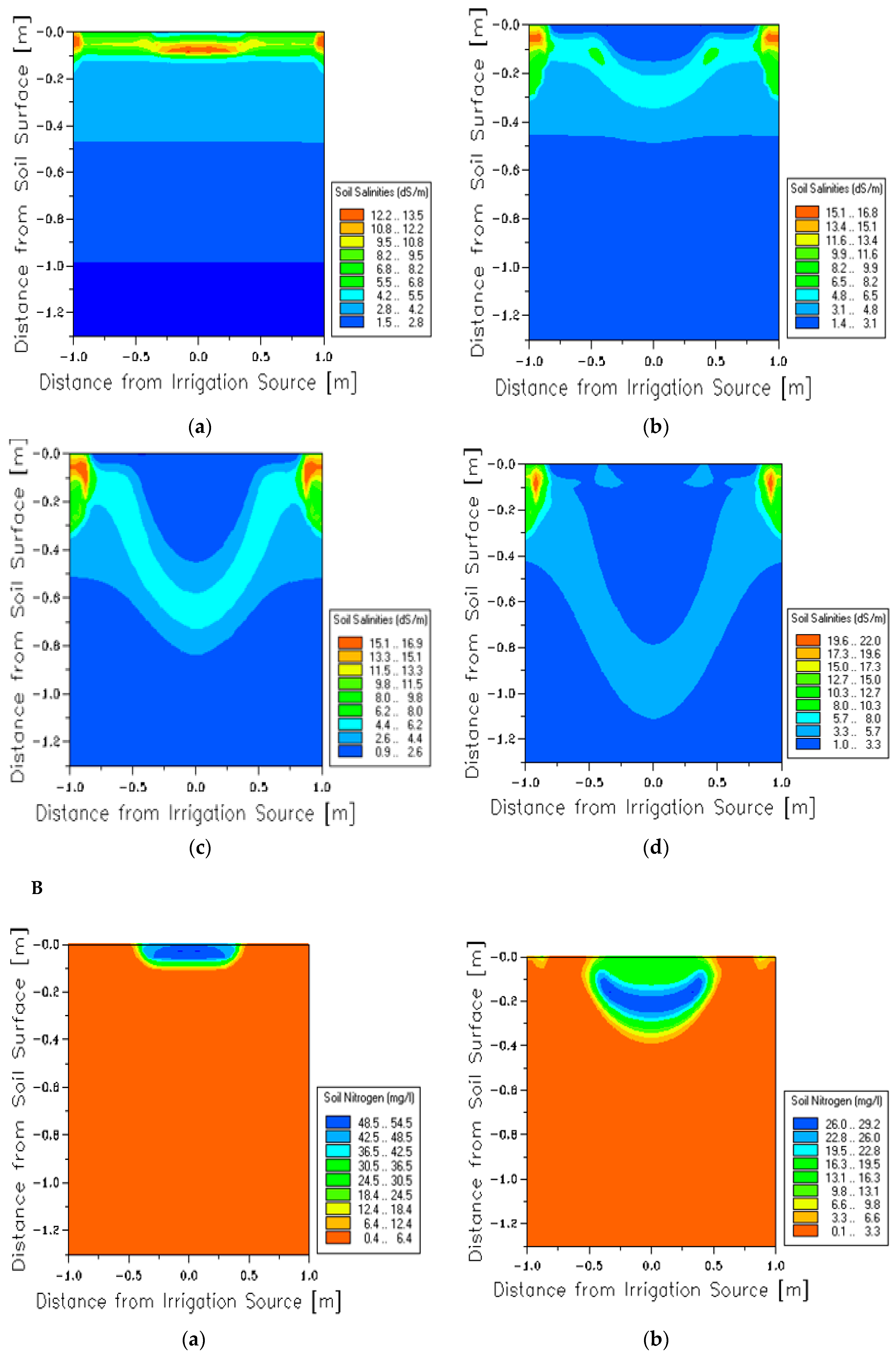
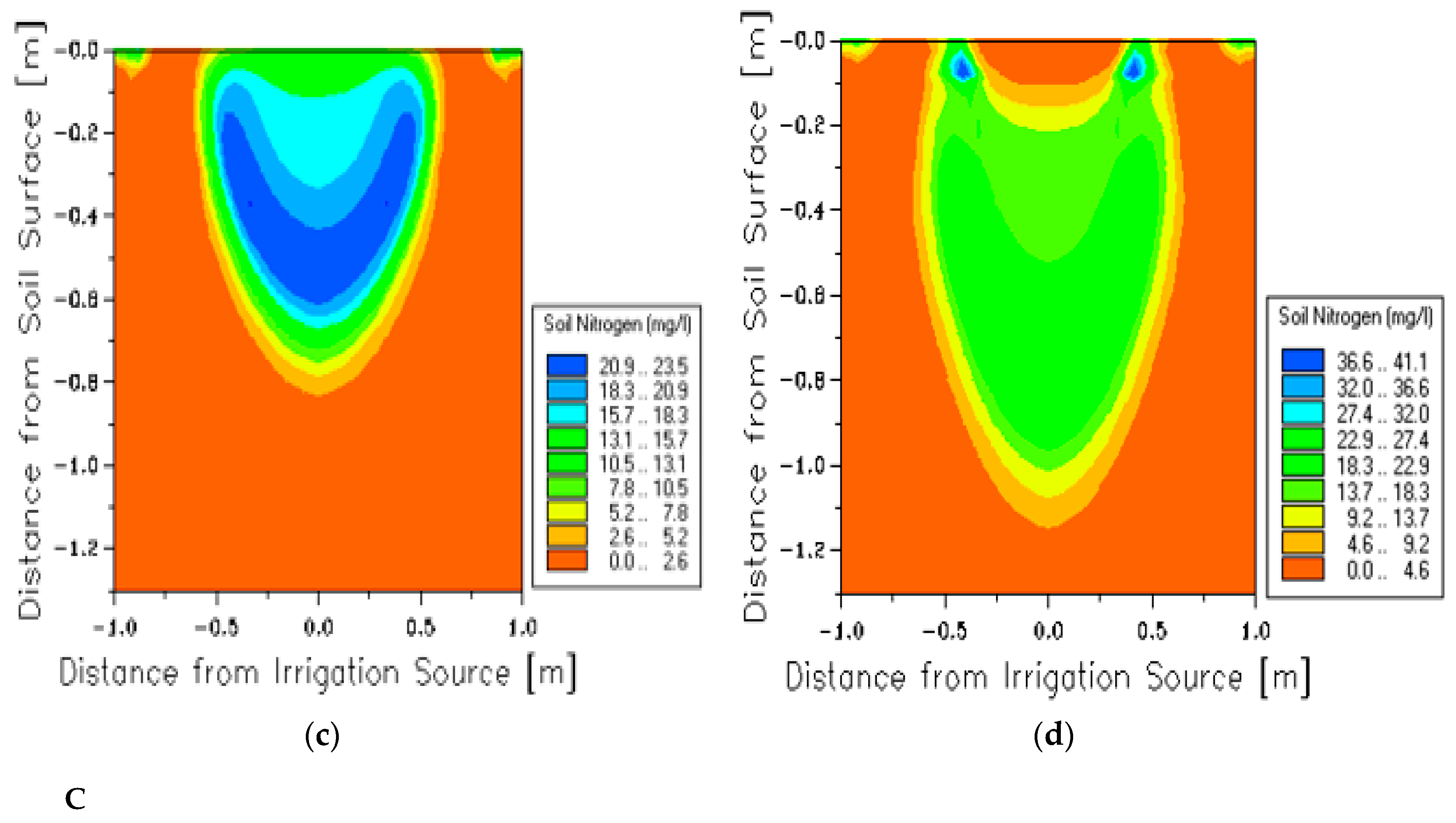

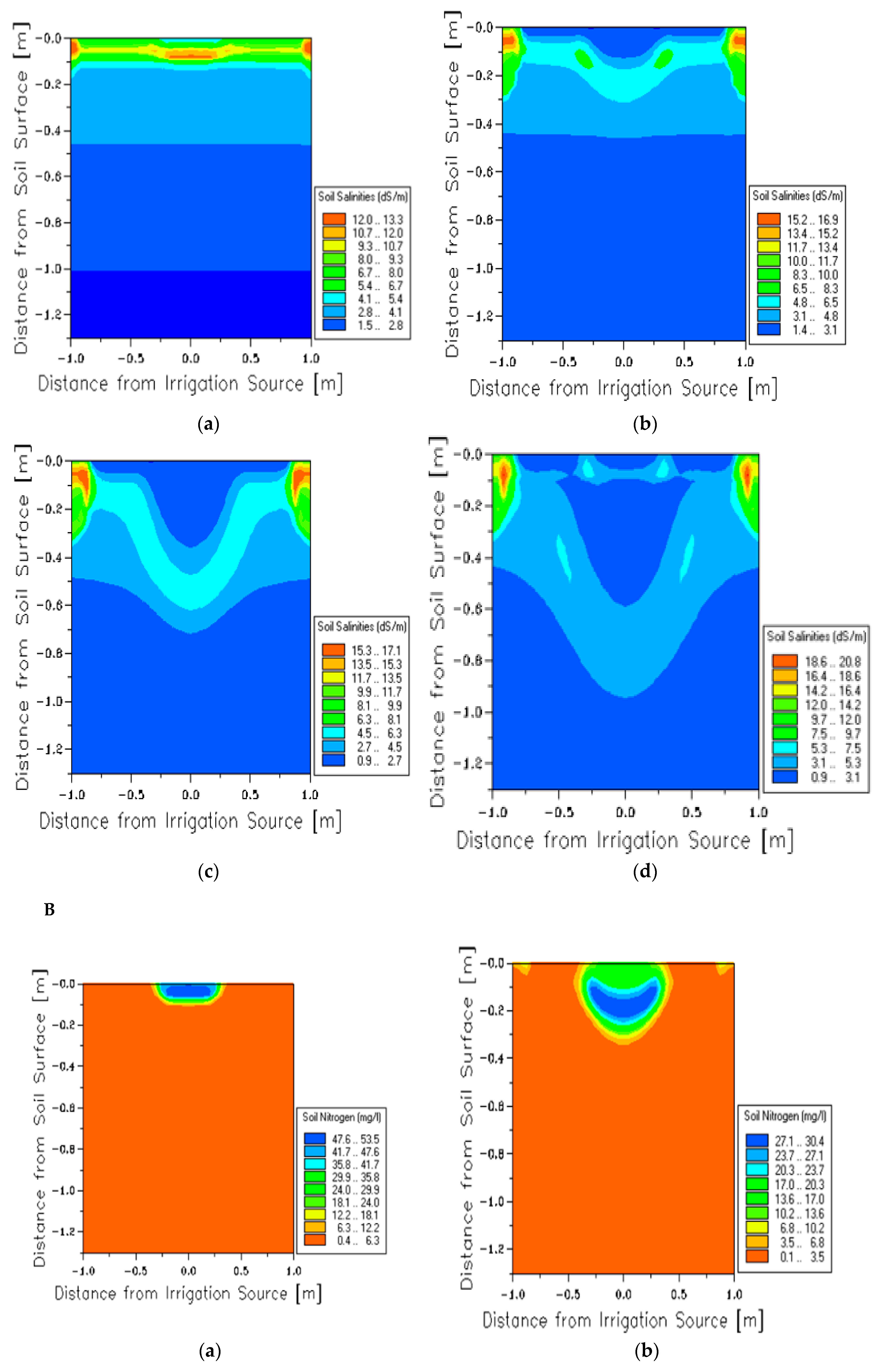

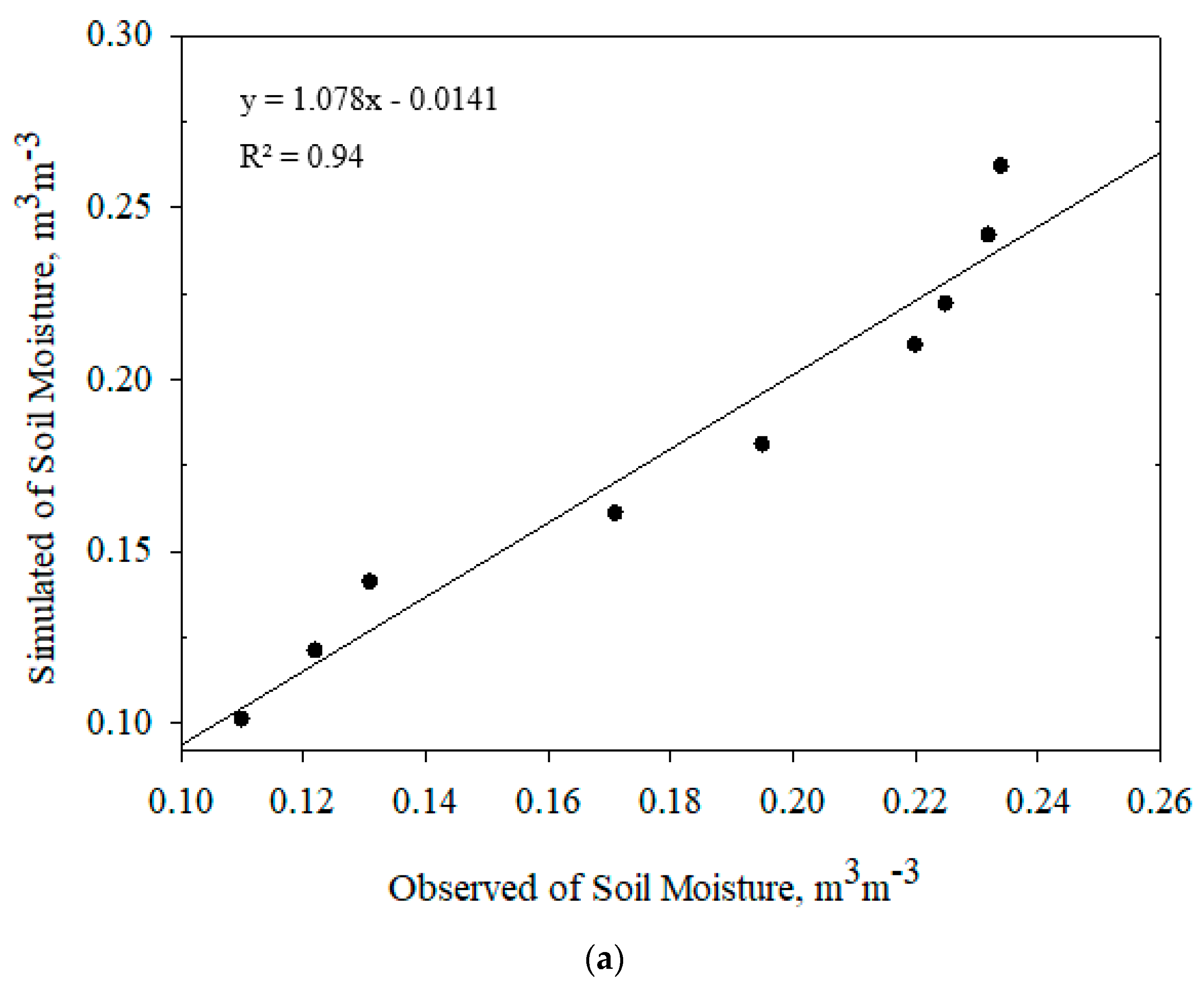
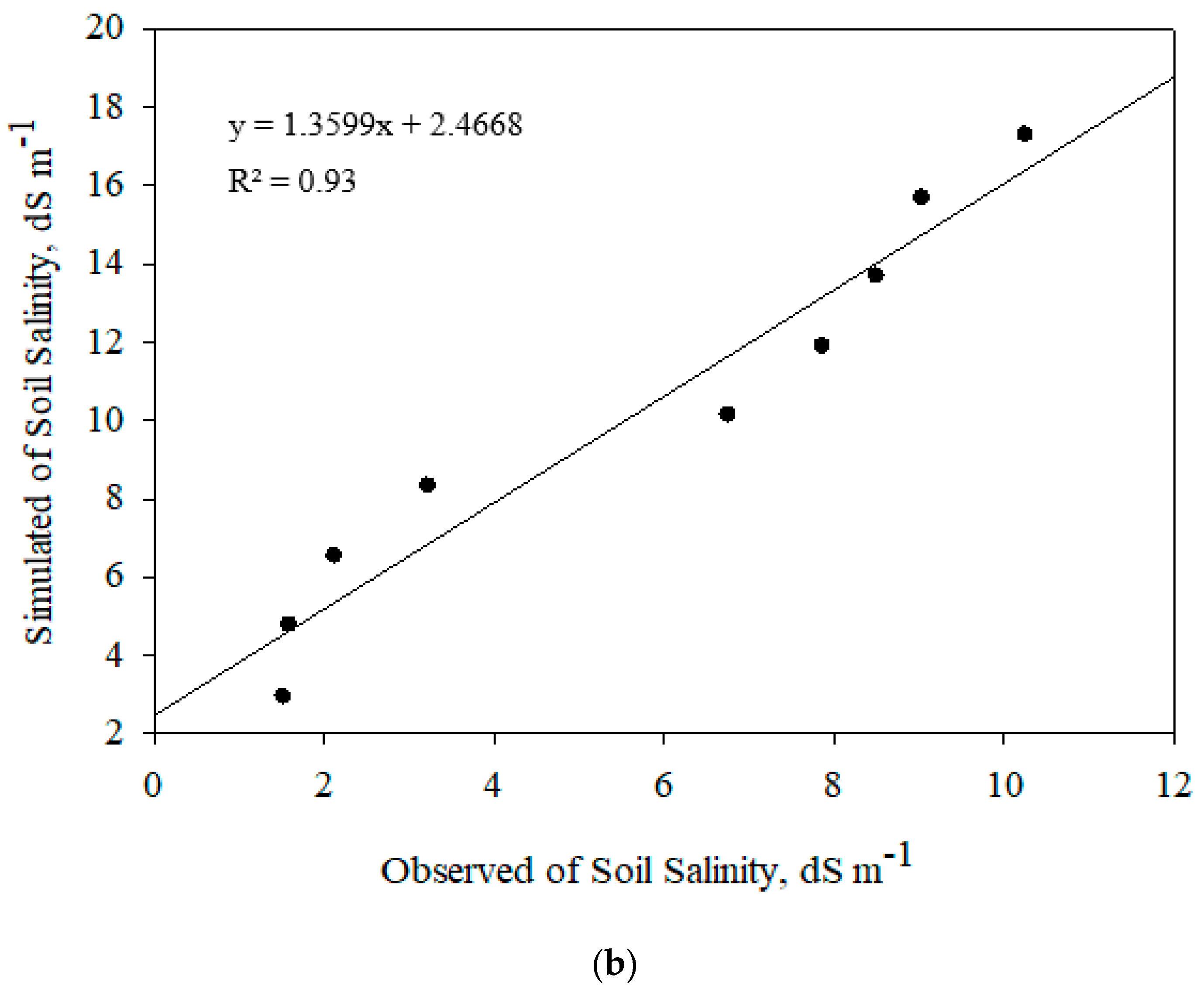
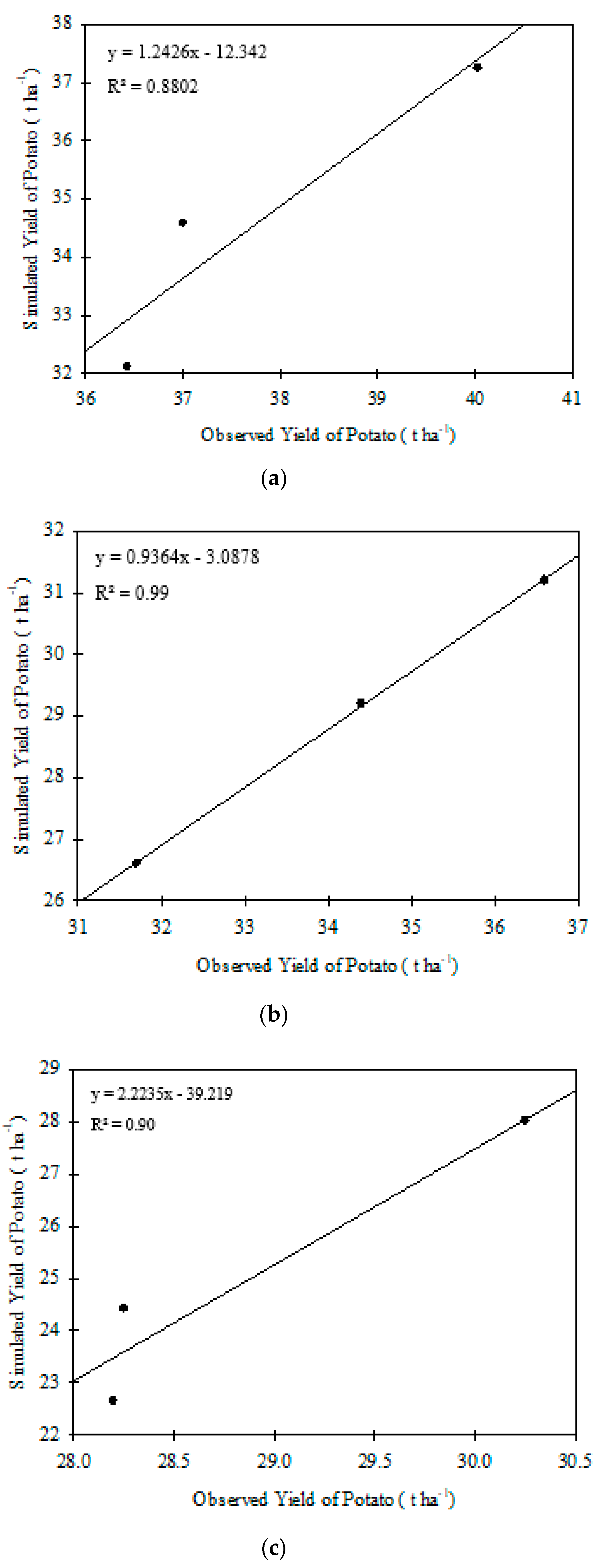
| Location | Sand% | Silt% | Clay% | Soil Texture | Bulk Density gcm−3 | O.M% | CaCo3% | S.P% |
|---|---|---|---|---|---|---|---|---|
| 1 | 75 | 15 | 10 | Sandy Loam | 1.51 | 1.1 | 18.8 | 26 |
| 2 | 80 | 7.5 | 12.5 | Sandy Loam | 1.56 | 0.9 | 19.9 | 24 |
| Sample | pH | E.C | Cations (meq L−1) | Anions (meq L−1) | SAR | |||||
|---|---|---|---|---|---|---|---|---|---|---|
| dS·m−1 | Ca+2 | Mg+2 | Na+1 | K+1 | Cl−1 | HCO3−1 | SO4−2 | |||
| Location Soil (1) | 7.27 | 13.61 | 55.2 | 22.5 | 35.78 | 12.72 | 53 | 9.9 | 63.7 | 5.74 |
| Location Soil (2) | 7.49 | 3.74 | 17.4 | 10.3 | 7.52 | 3.03 | 12.5 | 3.5 | 22.25 | 2.02 |
| Irrigation Water | 7.6 | 1.6 | 6.55 | 5 | 4.33 | 0.17 | 5.46 | 3.49 | 6.21 | 1.8 |
| Months | Temperature °C | Relative Humidity % | Wind Speed at 2m ms−1 | Evaporation mm | Soil Temperature °C | Radiation Langley day−1 | Hour of Sunshine H day−1 | ||
|---|---|---|---|---|---|---|---|---|---|
| Max. | Min. | Max. | Min. | ||||||
| January | 20.2 | 7.2 | 67 | 25 | 2.7 | 3.8 | 17 | 226 | 6.7 |
| February | 23.8 | 9.5 | 55 | 23 | 3.2 | 5.7 | 17.7 | 306 | 7.5 |
| March | 29.3 | 13.7 | 49 | 18 | 3.2 | 7.6 | 20.4 | 346 | 7.4 |
| April | 34.9 | 19.1 | 47 | 17 | 3.5 | 10.1 | 25.5 | 391 | 7.8 |
| May | 40.3 | 24.1 | 35 | 14 | 3.5 | 13.0 | 30.0 | 422 | 8.5 |
| June | 43.3 | 25.9 | 26 | 12 | 3 | 14.5 | 32.1 | 468 | 10.2 |
| July | 44.2 | 27.6 | 25 | 11 | 3 | 14.5 | 34.0 | 451 | 10.0 |
| August | 44.6 | 27.4 | 30 | 13 | 2.8 | 13.6 | 34.4 | 437 | 10.2 |
| September | 41.1 | 23.6 | 32 | 14 | 2.5 | 11.1 | 32.8 | 396 | 9.6 |
| October | 36.0 | 18.2 | 42 | 17 | 2.1 | 8.5 | 28.1 | 345 | 8.7 |
| November | 28.1 | 13.1 | 68 | 25 | 2.4 | 5.3 | 20.6 | 272 | 7.1 |
| December | 23 | 8.2 | 62 | 22 | 2.7 | 3.7 | 16.2 | 227 | 6.5 |
| Growth Stage | No. of Days after Planting | Kc—Evap. Pan | Kc-PM Methods | Kc—Alfalfa |
|---|---|---|---|---|
| Spring Season | ||||
| Kc (ini) early | 1 | 0.69 | 0.55 | 0.50 |
| Kc(ini) end | 20 | 0.69 | 0.55 | 0.50 |
| Kc (mid) early growth season | 47 | 1.00 | 1.16 | 0.91 |
| Kc (mid) early late growth season | 83 | 1.44 | 1.16 | 0.91 |
| Kc end of season | 98 | 1.37 | 1.05 | 0.79 |
| Fall season | ||||
| Kc (ini) early | 1 | 0.69 | 0.76 | 0.52 |
| Kc(ini) end | 20 | 0.69 | 0.76 | 0.52 |
| Kc (mid) early growth season | 47 | 1.20 | 1.41 | 0.93 |
| Kc (mid) early late growth season | 70 | 1.20 | 1.41 | 0.93 |
| Kc end of season | 79 | 0.88 | 1.07 | 0.65 |
| Method of Calculation of ETc | Spring Season | Fall Season |
|---|---|---|
| Actual water added at 100% | 616.0 | 582.2 |
| Lysimeter using reference crop | 740.0 | 642.2 |
| Evaporation Pan | 532.0 | 748.0 |
| Penman-Monteith | 546.0 | 974.0 |
| RMSE | 1.09 | 1.77 |
| (a) | ||||||||||
| ETc Calculated (mm) | Applied Water (mm) | ETc % | Yield PRD-S (Kg/m2) | WUE Kg/m3 | Yield PRD-SS (Kg/m2) | WUE Kg/m3 | Yield CDI-S (Kg/m2) | WUE Kg/m3 | Yield CDI-SS (Kg/m2) | WUE Kg/m3 |
| Spring Seasons | ||||||||||
| 616 | 783 | 100 | 3.17 | 4.05 | 3.11 | 3.97 | 3.21 | 4.10 | 3.26 | 4.16 |
| 616 | 783 | 100 | 3.44 | 4.40 | 3.32 | 4.24 | 3.59 | 4.48 | 3.62 | 4.62 |
| 616 | 783 | 100 | 3.66 | 4.67 | 3.27 | 4.18 | 3.43 | 4.38 | 3.60 | 4.60 |
| Mean | 3.42 b | 4.37 | 3.23 bc | 4.12 | 3.41 b | 4.36 | 3.50 ab | 4.47 | ||
| 462 | 587 | 75 | 3.33 | 5.67 | 2.55 | 4.34 | 2.98 | 4.92 | 2.59 | 4.41 |
| 462 | 587 | 75 | 2.99 | 5.09 | 2.98 | 5.07 | 3.03 | 5.16 | 2.66 | 4.53 |
| 462 | 587 | 75 | 3.33 | 5.67 | 2.89 | 4.92 | 2.90 | 4.94 | 2.72 | 4.63 |
| Mean | 3.22 b | 5.49 | 2.81 c | 4.79 | 2.97 b,c | 5.06 | 2.66 cd | 4.53 | ||
| 308 | 391 | 50 | 3.03 | 7.74 | 2.65 | 6.78 | 2.62 | 6.70 | 2.41 | 6.16 |
| 308 | 391 | 50 | 2.82 | 7.21 | 2.57 | 6.57 | 3.27 | 8.36 | 2.43 | 6.21 |
| 308 | 391 | 50 | 2.83 | 7.24 | 2.62 | 6.70 | 2.94 | 7.52 | 2.74 | 7.01 |
| Mean | 2.89 c | 7.62 | 2.61 c,d | 6.67 | 2.94 b,c | 7.52 | 2.53 c,d | 6.47 | ||
| 616 | 1174 | 150 | 4.00 | 3.40 | 3.73 | 3.18 | 3.73 | 3.18 | 3.58 | 3.05 |
| 616 | 1174 | 150 | 3.70 | 3.15 | 3.47 | 2.96 | 3.34 | 2.85 | 3.31 | 2.82 |
| 616 | 1174 | 150 | 3.64 | 3.10 | 3.40 | 3.73 | 3.49 | 2.97 | 3.25 | 2.77 |
| mean | 3.78 a,b | 3.22 | 3.53 a,b | 3.01 | 3.59 a,b | 3.06 | 3.38 b | 2.88 | ||
| (b) | ||||||||||
| ETc Calculated (mm) | Applied Water (mm) | ETc % | Yield PRD-S (Kg/m2) | WUE Kg/m3 | Yield PRD-SS (Kg/m2) | WUE Kg/m3 | Yield CDI-S (Kg/m2) | WUE Kg/m3 | Yield CDI-SS (Kg/m2) | WUE Kg/m3 |
| Spring Seasons | ||||||||||
| 485.3 | 616.7 | 100 | 3.18 | 5.16 | 3.05 | 4.95 | 2.89 | 4.69 | 3.27 | 5.31 |
| 485.3 | 616.7 | 100 | 3.18 | 516 | 3.68 | 5.97 | 3.18 | 5.16 | 3.58 | 5.81 |
| 485.3 | 616.7 | 100 | 3.62 | 5.88 | 3.31 | 5.37 | 2.99 | 4.85 | 3.61 | 5.86 |
| Mean | 3.33 a,b | 5.40 | 3.35 a,b | 5.44 | 3.02b | 4.90 | 3.48 a,b | 5.65 | ||
| 364 | 463.2 | 75 | 2.91 | 6.29 | 2.71 | 5.84 | 2.15 | 4.64 | 2.40 | 5.18 |
| 364 | 462.2 | 75 | 2.70 | 5.83 | 2.77 | 5.98 | 2.46 | 5.70 | 2.11 | 4.55 |
| 364 | 462.2 | 75 | 2.83 | 6.11 | 2.63 | 5.68 | 2.21 | 4.77 | 2.23 | 4.81 |
| Mean | 2.81 b,c | 6.07 | 2.70 b,c | 5.83 | 2.30 b,c | 4.97 | 2.24 c | 4.84 | ||
| 242.7 | 308.15 | 50 | 2.09 | 6.79 | 2.20 | 7.14 | 1.81 | 5.87 | 1.94 | 6.3 |
| 242.7 | 308.15 | 50 | 1.97 | 6.40 | 2.58 | 8.38 | 1.81 | 5.87 | 1.74 | 5.65 |
| 242.7 | 308.15 | 50 | 1.90 | 6.17 | 2.29 | 7.44 | 1.87 | 6.07 | 1.94 | 6.30 |
| Mean | 1.99 d | 6.46 | 2.36 c,d | 7.66 | 1.81 d | 5.87 | 1.87 d | 6.07 | ||
| 485.3 | 924.5 | 150 | 3.23 | 3.49 | 3.84 | 4.15 | 3.86 | 4.17 | 4.12 | 4.46 |
| 485.3 | 924.5 | 150 | 3.33 | 3.60 | 3.77 | 4.08 | 3.50 | 3.78 | 3.17 | 3.43 |
| 485.3 | 924.5 | 150 | 2.98 | 3.22 | 3.12 | 3.37 | 3.29 | 3.56 | 3.41 | 3.69 |
| Mean | 3.18 b | 3.44 | 3.38 a,b | 3.66 | 3.55 a,b | 3.84 | 3.57 a,b | 3.86 | ||
| Treatment | MAD | MSE | RSME | MAPE | MRE | CRM | R2 |
|---|---|---|---|---|---|---|---|
| SM | 0.01056 | 0.00016 | 0.01278 | 5.75750 | 0.00011 | –0.00061 | 0.94561 |
| SS | 4.50000 | 22.97829 | 4.79357 | 107.52623 | 4.50000 | −0.79662 | 0.93944 |
| 150 | 3.16551 | 10.69341 | 3.27008 | 8.42691 | −3.16551 | 0.08370 | 0.88020 |
| 100 | 5.26852 | 27.77429 | 5.27013 | 15.40583 | −5.26852 | 0.15374 | 0.99982 |
| 50 | 3.86148 | 16.73179 | 4.09045 | 13.50786 | −3.86148 | 0.13362 | 0.90908 |
| % of ETc | Observed, t ha−1 | Simulated, t ha−1 | RE % |
|---|---|---|---|
| 150 | 40.03 | 37.25 | 6.95 |
| 37.00 | 34.59 | 6.51 | |
| 36.43 | 32.12 | 11.82 | |
| 100 | 31.72 | 26.60 | 16.15 |
| 34.44 | 29.20 | 15.23 | |
| 36.64 | 31.20 | 14.84 | |
| 50 | 30.25 | 28.02 | 7.37 |
| 28.19 | 22.66 | 19.63 | |
| 28.25 | 24.43 | 13.52 |
Publisher’s Note: MDPI stays neutral with regard to jurisdictional claims in published maps and institutional affiliations. |
© 2020 by the authors. Licensee MDPI, Basel, Switzerland. This article is an open access article distributed under the terms and conditions of the Creative Commons Attribution (CC BY) license (http://creativecommons.org/licenses/by/4.0/).
Share and Cite
Al-Omran, A.; Louki, I.; Alkhasha, A.; Abd El-Wahed, M.H.; Obadi, A. Water Saving and Yield of Potatoes under Partial Root-Zone Drying Drip Irrigation Technique: Field and Modelling Study Using SALTMED Model in Saudi Arabia. Agronomy 2020, 10, 1997. https://doi.org/10.3390/agronomy10121997
Al-Omran A, Louki I, Alkhasha A, Abd El-Wahed MH, Obadi A. Water Saving and Yield of Potatoes under Partial Root-Zone Drying Drip Irrigation Technique: Field and Modelling Study Using SALTMED Model in Saudi Arabia. Agronomy. 2020; 10(12):1997. https://doi.org/10.3390/agronomy10121997
Chicago/Turabian StyleAl-Omran, Abdulrasoul, Ibrahim Louki, Arafat Alkhasha, Mohamed Hassan Abd El-Wahed, and Abdullah Obadi. 2020. "Water Saving and Yield of Potatoes under Partial Root-Zone Drying Drip Irrigation Technique: Field and Modelling Study Using SALTMED Model in Saudi Arabia" Agronomy 10, no. 12: 1997. https://doi.org/10.3390/agronomy10121997
APA StyleAl-Omran, A., Louki, I., Alkhasha, A., Abd El-Wahed, M. H., & Obadi, A. (2020). Water Saving and Yield of Potatoes under Partial Root-Zone Drying Drip Irrigation Technique: Field and Modelling Study Using SALTMED Model in Saudi Arabia. Agronomy, 10(12), 1997. https://doi.org/10.3390/agronomy10121997






